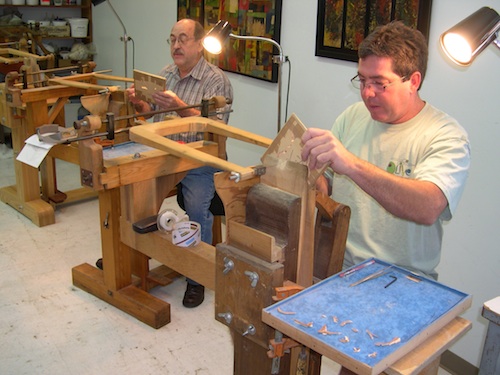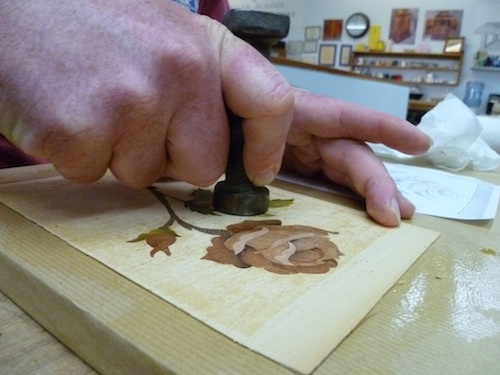 Like in Paris, ASFM students perform various "etudes" in marquetry, increasing in complexity, using two primary methods:
Like in Paris, ASFM students perform various "etudes" in marquetry, increasing in complexity, using two primary methods:
The Boulle Technique, which requires cutting all the elements of the design simultaneously with the background. Stage I students will complete three different Boulle projects with wood veneers during the class, making a total of 13 different pictures.
The first project is a Fleur de Lys in three colors.
The second project is a self portrait in 4 copies that you will design yourself. With Kristen Arrivee, a former Art Teacher, you will learn how to draw a marquetry and we will alos assist you in the veneer choices.
For the last project you will be making 6 coaters. This is the last exercice of the week and is slightly more chalenging.
 The Classic Method, or piece by piece, requires that each of the design elements be cut independently of the background. At some time in the mid-18th century, the Classic Method was developed in Paris workshops to meet the popular demand for highly decorated marquetry furniture. It served the trade nicely, since it allowed for an infinite variety of woods, bone, horn, tortoise-shell, ivory, brass and pewter to be used in the designs. But the real advantage in the Classic Method was that it allowed production of many copies of marquetry panels at the same time with very little extra effort.
The Classic Method, or piece by piece, requires that each of the design elements be cut independently of the background. At some time in the mid-18th century, the Classic Method was developed in Paris workshops to meet the popular demand for highly decorated marquetry furniture. It served the trade nicely, since it allowed for an infinite variety of woods, bone, horn, tortoise-shell, ivory, brass and pewter to be used in the designs. But the real advantage in the Classic Method was that it allowed production of many copies of marquetry panels at the same time with very little extra effort.
The procedure used in the Classic Method is to create many identical copies of the original design on paper, using a "machine a pique". This machine is like a system for making tattoos, and is used to pick the design onto a Kraft paper. This "picked" pattern is used to create a dozen exact copies, which are cut up in the process. The original "picked" pattern is saved for future use, and often remains usable for many decades. Nowaday we have acces to vector programs such as illustrator or inkscape that can achieve digital similar results.
 The students at ASFM create packets of veneers and other exotic materials according to the requirements of the design. The individual elements of the drawing are cut out in paper (from the copies of the design) which are glued onto the face of the veneer packets. Stage II students will complete a traditional floral picture, in three copies, with hot sand shading for dramatic effect by "burning the marquetry elements.
The students at ASFM create packets of veneers and other exotic materials according to the requirements of the design. The individual elements of the drawing are cut out in paper (from the copies of the design) which are glued onto the face of the veneer packets. Stage II students will complete a traditional floral picture, in three copies, with hot sand shading for dramatic effect by "burning the marquetry elements.
The "chevalet de marqueterie" allows for extremely precise and delicate cutting. The carriage which guides the hand operated saw frame keeps the blade perpendicular. The lines of the design are about a tenth of a millimeter wide, and, if your eyes are good enough, you can saw away the "outside" half of the line. Thus, by sawing away the "outside" half of the line for all the "inside" pieces of the design, you can then saw away the "inside" half of the line for the "outside" (background). This method eliminates the saw kerf completely, using perpendicular cutting, and allows from 8 to 12 copies to be produced at one time.
Once all of the elements are cut out, they are each placed in hot sand for a few seconds at a variety of angles and depths for "shading" effects. The hot sand "burns" each of the woods differently, according to density, and wonderfully realistic shadow effects result.
At ASFM, the majority of the work in preparing the veneer packets, designs, sand shadowing and marquetry assembly takes place on these work benches. Here the students have access to specific work areas for each process. The different drawers contain materials, designs and tools for the classes and each student is assigned a parts tray for their projects.
Located along the west wall of windows at ASFM are three of the seven "chevalet de marqueterie", which vary in size to accommodate each student's personal physique. The tallest chevalet in the back would be used by someone over 6' while the two in the foreground fit students under 6' more comfortably. One of these chevalets can be converted to operate left handed, but are normally set up for right hand workers.
Since there are a total of seven chevalets, the class size is limited to a maximum of six students at a time. In addition to the standard chevalets, there are two vertical saws which stand in another corner of the classroom. The largest of these has a throat clearance of nearly 5 feet, and operates by motor at 180 strokes per minute. It uses an ash bow for support, and is driven by a wide leather belt, with a foot clutch to vary the speed.
The second vertical saw is an antique saw which was donated by marquetry friends in Alsace, France. It was originally used by one of the workers in the workshop of Spindler, a well known three generation marquetry studio in Alsace. It is powered by foot action, which moves a large wood frame saw vertically, leaving both hands free to manipulate the work.

 Like in Paris, ASFM students perform various "etudes" in marquetry, increasing in complexity, using two primary methods:
Like in Paris, ASFM students perform various "etudes" in marquetry, increasing in complexity, using two primary methods: The Classic Method, or piece by piece, requires that each of the design elements be cut independently of the background. At some time in the mid-18th century, the Classic Method was developed in Paris workshops to meet the popular demand for highly decorated marquetry furniture. It served the trade nicely, since it allowed for an infinite variety of woods, bone, horn, tortoise-shell, ivory, brass and pewter to be used in the designs. But the real advantage in the Classic Method was that it allowed production of many copies of marquetry panels at the same time with very little extra effort.
The Classic Method, or piece by piece, requires that each of the design elements be cut independently of the background. At some time in the mid-18th century, the Classic Method was developed in Paris workshops to meet the popular demand for highly decorated marquetry furniture. It served the trade nicely, since it allowed for an infinite variety of woods, bone, horn, tortoise-shell, ivory, brass and pewter to be used in the designs. But the real advantage in the Classic Method was that it allowed production of many copies of marquetry panels at the same time with very little extra effort. The students at ASFM create packets of veneers and other exotic materials according to the requirements of the design. The individual elements of the drawing are cut out in paper (from the copies of the design) which are glued onto the face of the veneer packets. Stage II students will complete a traditional floral picture, in three copies, with hot sand shading for dramatic effect by "burning the marquetry elements.
The students at ASFM create packets of veneers and other exotic materials according to the requirements of the design. The individual elements of the drawing are cut out in paper (from the copies of the design) which are glued onto the face of the veneer packets. Stage II students will complete a traditional floral picture, in three copies, with hot sand shading for dramatic effect by "burning the marquetry elements.